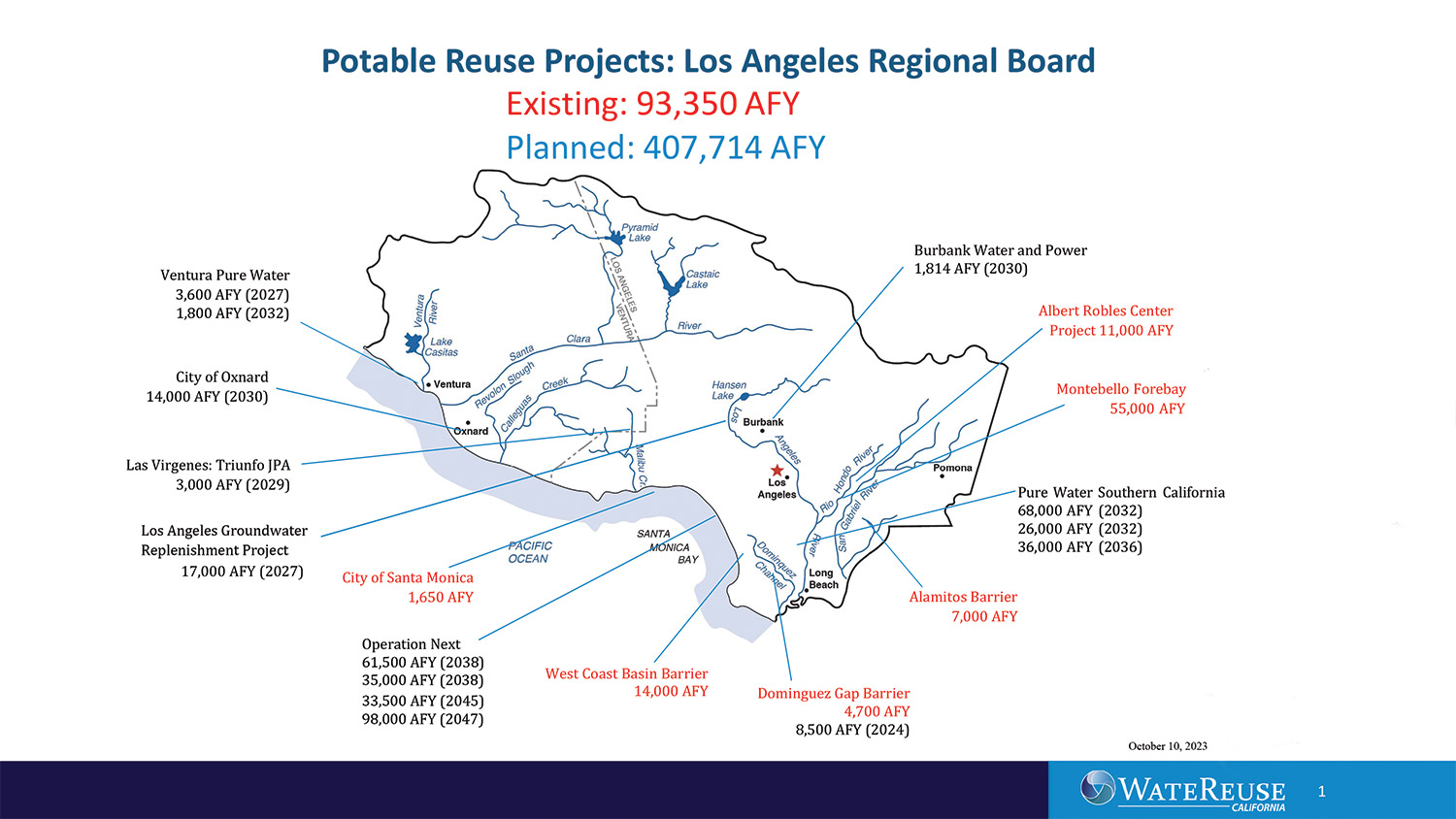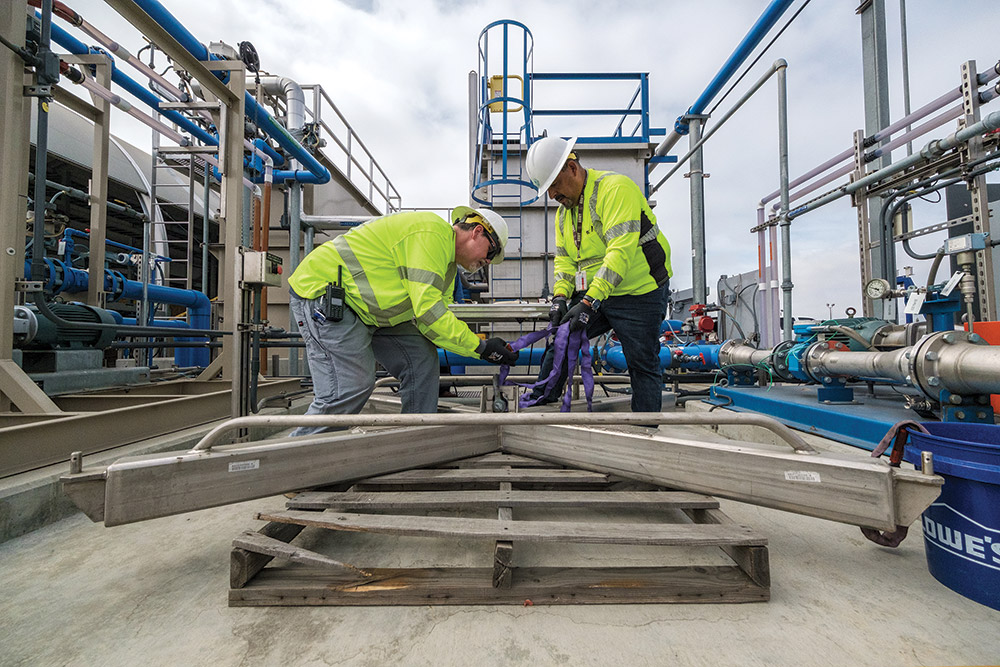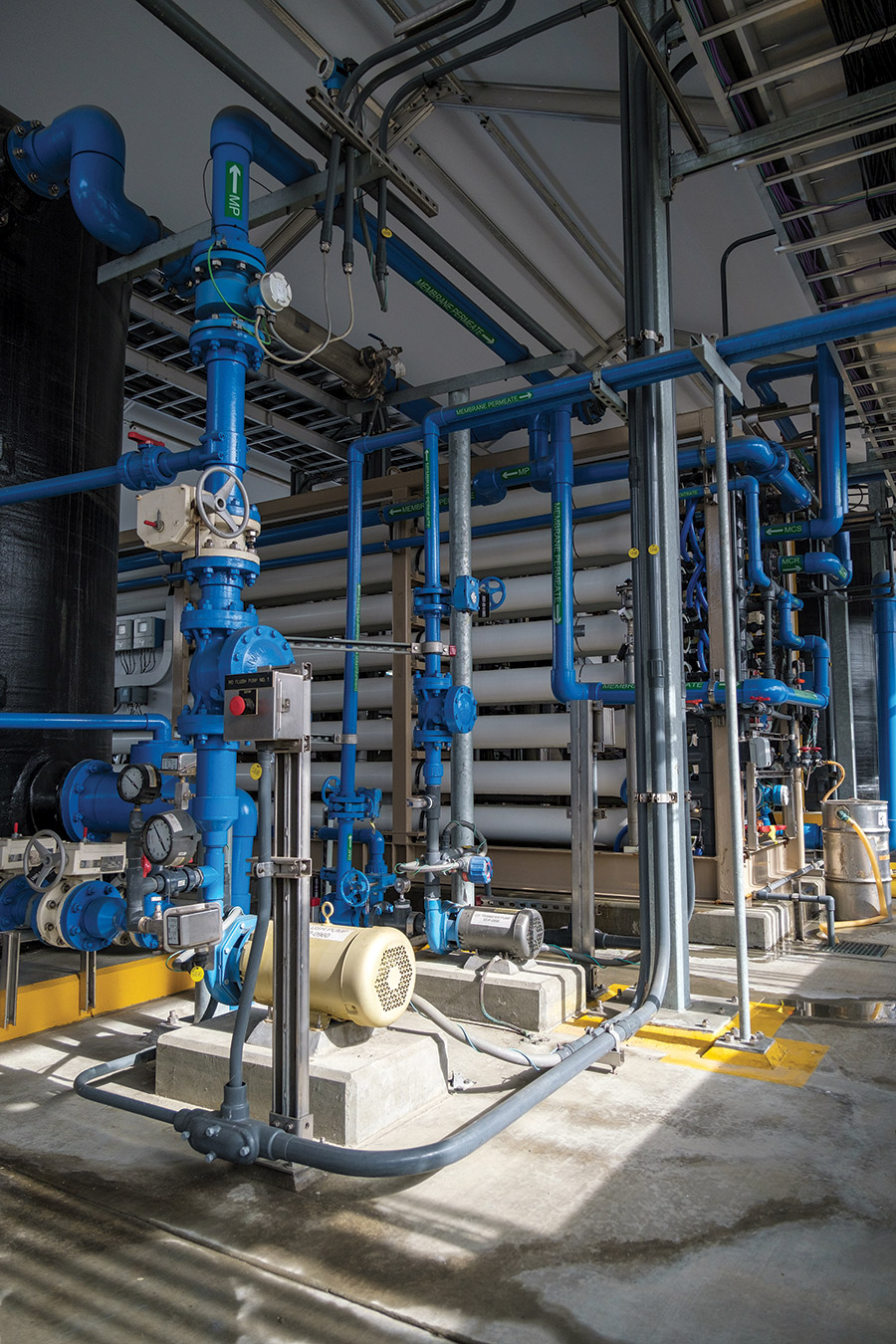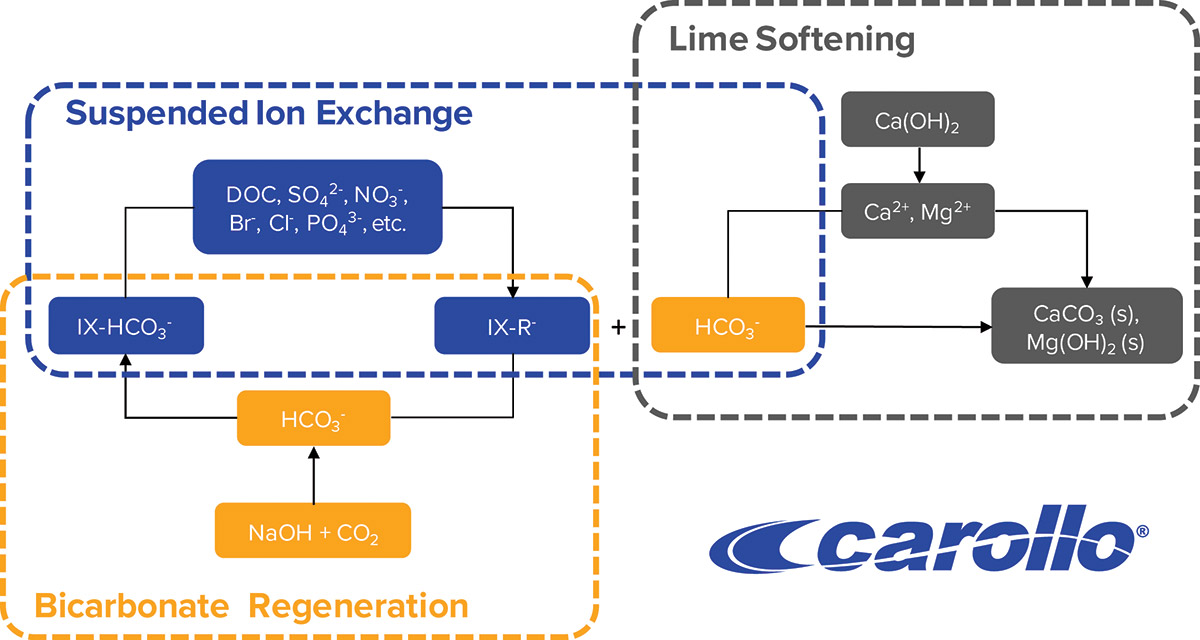ENR 2024 Water Report: Managers Look to Potable Water Reuse
June 12, 2024
ENR 2024 Water Report: Managers Look to Potable Water Reuse
June 12, 2024Dropping water levels at Lake Powell on the Arizona-Utah border (below) and elsewhere in the U.S. are driving efforts such as the Las Virgenes-Triunfo project in California (above), which will blend effluent treated at a new advanced purification facility with water from the Las Virgenes reservoir.
Photo courtesy of Jacobs
With nearly all seven states within the 250,000-sq-mile Colorado River basin scrambling to conserve their apportionments from the river system’s increasingly depleted resources, interest in securing alternative local drinking water supplies is soaring.
The growing uncertainty of water supply amid increasing climate change impacts has given new prominence to potable reuse—treating wastewater effluent to drinking water standards so it can be funneled into water distribution networks, either indirectly into reservoirs and groundwater or directly into drinking-water pipes.
Multiple multibillion-dollar potable reuse programs, largely concentrated in California and other western states but also throughout the U.S., have been in design and pilot phases for much of the past decade. Despite ongoing public concerns, the pilot plants that have come online have demonstrated that treatment methods being used are safe—a requirement to receive permits necessary to move forward to full-scale construction.
“It’s a very exciting time for potable reuse where its potential is beginning to be realized thanks to longstanding collaboration among utilities, regulators, consultants and research organizations,” says Julie Minton, research unit leader at the Water Research Foundation, a research organization dedicated to advancing the science of water.

Dropping water levels at Lake Powell on the Arizona-Utah border (above) and elsewhere in the U.S. are driving efforts such as the Las Virgenes-Triunfo project in California (top), which will blend effluent treated at a new advanced purification facility with water from the Las Virgenes reservoir.
Photo: AP Photo/Ross D. Franklin, File
Water reclamation in one form or another has actually been in practice for millennia. Initially, any waste discharged and diluted into bodies of water that filtered downstream into drinking water sources could be considered “reused.”
Intentional indirect potable reuse, in which treated effluent is purposefully injected into groundwater or aquifers to blend with raw water and eventually flow into drinking water reservoirs, is more recent, with the first U.S. projects built in the 1960s. But western cities such as San Diego, which import more water than they produce, are increasingly looking to indirect potable reuse to reduce their vulnerability both to climate events and skyrocketing costs associated with importing their supply.
Interest also is rising in direct potable reuse, which involves piping treated effluent directly into the drinking water distribution system, say industry firms active in the water sector.
One of the first such projects in the U.S., a 10-million-gallon-per day advanced purification facility in El Paso, Texas, is expected to break ground early in 2025. Local utility EPWater has a track record of being ahead of the curve—building one of the country’s first inland desalination plants and using indirect potable reuse for more than three decades.
According to EPWater officials, the new advanced purification facility will be the first direct potable reuse project of its kind in the U.S. The purified water will supplement local supplies during dry seasons and reduce amounts that are withdrawn from the Rio Grande.
Membrane bioreactors “make a lot of sense” for new potable reuse projects.
Larry Schimmoller, global principal for water reuse, Jacobs
For treated effluent to become potable, it must receive advanced treatment—usually using some combination of several phases of microfiltration, reverse osmosis, ultraviolet light with hydrogen peroxide, chlorination and granular activated carbon following secondary treatment.
More stringent federal and state regulations that now require water utilities to treat wastewater to levels that necessitate increasingly expensive advanced treatment, as well as growing public acceptance of water reuse, makes the direct reuse approach almost a no-brainer, says Richard Hewitt, PCL Construction vice president and district manager. The firm is partnered with Sundt Construction on the El Paso advanced purification facility, with Carollo Engineers providing design services on the CM-at-risk project. A pilot facility has been operating there since 2016.
“All treatment of water is starting to get more and more expensive,” says Hewitt. “So the difference in paying for a reuse system versus just regular treatment is that the gap is getting smaller.”
Cities in Florida, Colorado, Tennessee, Utah and Arizona are also likely to develop potable reuse programs over the next decades.

*Click the map for greater detail
Map Courtesy of Water Reuse Association
California Advances Potable Reuse
California agencies have been among the most active in advancing potable reuse. Brenley McKenna, managing director of the Water Reuse Association’s California chapter, says the scale of projects now underway is “unlike anything we’ve seen before.” Despite the hefty price tag, which can run in excess of $3 billion in some cases, “because of the need, it still makes sense,” says McKenna. “Recycling water is still one of the more viable options to create a sustainable and locally controlled supply.”
“All treatment of water is starting to get more and more expensive, so the difference in paying for a reuse system versus just regular treatment is that the gap is getting smaller.”
Richard Hewitt Vice President and District Manager, PCL Construction
Orange County’s water and sanitation districts completed work last year on one of the world’s largest indirect potable reuse programs, the Groundwater Replenishment System. The project was expanded twice over the course of its 17-year development to reach a total capacity of 130 mgd. In the system, highly treated wastewater that would have been discharged into the Pacific Ocean is further purified at an advanced facility before injection into groundwater basins in the county.
Also in the works in California are three multibillion-dollar potable reuse programs, along with dozens of smaller projects. With state regulators expected to enact more stringent limits on Pacific effluent discharges within the next few years, many water agencies are considering potable reuse, says Zakir Hirani, vice president and water reuse practice lead at Stantec. “The wastewater agencies want to minimize ocean discharge, and the drinking water agencies want to create new supply. Potable reuse fits perfectly into this scenario,” he says.


Equipment at a pilot facility for PURE Water Southern California, including for reverse osmosis (above, right) was installed at full scale to provide accurate data, according to Metropolitan Water District of Southern California.
Photos courtesy of Metropolitan Water District of Southern California
The Metropolitan Water District of Southern California is partnering with the Los Angeles County Sanitation District on a $6.3-billion, 150 mgd indirect and direct water reuse effort called the PURE Water Southern California program. It is set to begin producing water in the early 2030s.
As part of the program, a 500,000-gpd pilot plant with full-scale reverse osmosis and membrane bioreactor equipment has been operating in Carson, Calif., since 2019. “We’ve gathered a lot of really good data that confirms the validity of our treatment process,” says John Bednarski, the agency’s chief engineer.
The Los Angeles Dept. of Water and Power is partnering with the Los Angeles Sanitation and Environment Dept. to retrofit the Hyperion reclamation plant to produce 170 mgd of purified water for potable use by 2035. Additionally, a small 1.5-mgd plant will produce recycled water for Los Angeles International Airport.
A 1-mgd pilot demonstration plant will soon begin treating wastewater, Stantec’s Hirani says. The 1-mgd demonstration plant, which finished construction this year, is undergoing clean water testing and may begin treating wastewater late this year.
Stantec is providing treatment-related engineering services for the environmental planning phase for Metropolitan’s project and program management support services with Carollo at Hyperion.
San Diego is wrapping up construction projects related to Phase 1 of Pure Water San Diego, a multi-year potable reuse program that will allow the city to provide nearly half of its water supply locally by 2035, with 12 different projects set to produce up to 30 mgd of potable water. Phase 2, which will produce another 53 mgd when complete, is in the planning stage.
Almost all of the planned California projects use membrane bioreactors, which combine two steps of secondary treatment: aeration and clarifiers, to remove pollutants. Not only does membrane bioreactor treatment have a smaller footprint in combining two treatment steps into one, it also produces higher-quality water because effluent is filtered through a membrane, says Larry Schimmoller, global principal for water reuse at Jacobs. The treatment process “seems like a better approach for potable reuse if you’re starting new, and [it] makes a lot of sense if you have to go to a reverse osmosis system downstream,” he says.
Jacobs has evaluated the feasibility of using membrane bioreactor treatment at several of the California projects. The firm also is progressive-design build contractor for the new Donald C. Tillman advanced water purification facility for LA Sanitation and Environment and the Dept. of Water and Power, which is now in the design phase. It will treat tertiary effluent from the existing Tillman water reclamation plant to produce purified water suitable for groundwater replenishment.
XBAT: Promising Alternative Approach Under Development
Reverse osmosis is generally considered a standard approach for potable water reuse projects. But because of the costs, as well as the concentrated brine that remains after the treatment, water agencies that don’t have access to either large bodies of water or deep injection wells to dispose of the concentrate can be unsure how to proceed, says Eva Steinle-Darling, water reuse technical practice director and senior vice president at Carollo Engineers.
Carbon-based advanced treatment, another approach, doesn’t create a significant concentrate, but it also doesn’t remove salts—a problem for some systems with brackish, high-salinity water, she adds.
Carollo has been performing bench studies on a new approach that it contends removes contaminants without the problems associated with reverse osmosis and carbon-based treatment. The process, called XBAT, combines suspended ion exchange advanced treatment with lime softening to remove contaminants and convert saline water to a bicarbonate that can be removed through chemical precipitation. The bicarbonate is “hard, it’s a very hard waste product, but it’s less than 1% of the total flow, and there’s more potential for us to be able to recycle it” in additional wastewater treatment processes where the substance could be useful, Steinle-Darling notes. “Then it’s suddenly no longer a waste stream; it’s recycling.”
Carollo holds two patents on the technology as it continues to perform bench-scale testing. The firm is currently upscaling evaluations of XBAT with an advanced wastewater treatment pilot in Tampa, Fla., and a direct potable reuse treatment feasibility assessment for Aurora Water in Aurora, Colo.
“XBAT signifies a transformative evolution in water treatment, particularly for communities facing moderate salinity obstacles, Steinle-Darling says. “By providing an alternative to reverse osmosis-based methods, XBAT empowers utilities to enhance efficiency, reliability and sustainability while advancing the future of responsible water management.”
By Pam McFarland

Diagram courtesy of Carollo

The SIX suspended ion exchange system, effective at removing total organic compounds through a regenerative process, is a key component of Carollo’s XBAT treatment method. SIX was developed by PWNT in the Netherlands.
Diagram courtesy of Carollo
Roadblocks
One of the challenges faced by indirect and direct potable reuse proponents is the enormous costs of multi-year programs. Because most government regulations require pilot plants to operate for several years before full-scale construction can begin, programs can easily run into the billions of dollars.
In California, the scale of projects now underway is “unlike anything we’ve seen before.”
Brenley McKenna Managing director, Water Reuse Assn., California Chapter
Most water agencies typically prefer to obtain federal and state support instead of raising customer rates. Earlier this year, California Gov. Gavin Newsom (D) proposed trimming state funding for water recycling programs by more than $200 million. But Hirani notes that because most potable reuse projects being planned are part of multi-year programs, slight reductions year to year are unlikely to stall projects already underway.
Several programs have received funding through the federal Infrastructure Investment and Jobs Act (IIJA). U.S. Bureau of Reclamation officials announced on May 29 $450 million in IIJA funding over the next five years under its Large-Scale Water Recycling Program to support major projects in the western U.S.—with funding earmarked for both Metropolitan’s Pure Water program and the Los Angeles agency projects.
Another hurdle for widespread implementation of potable reuse projects is the need for a regulatory framework before they can gain necessary construction permits. No federal standards for potable reuse exist, largely because of varied needs in different regions of the country, says Eva Steinle-Darling, Carollo water reuse technical practice director and senior vice president. Federal drinking water and clean water quality standards are very well established, but potable reuse falls into a gap between the two, she says. “By virtue of climates and population growth, some states have filled that gap much more quickly than others,” she adds.

A rendering of the advanced purification facility that will be built in El Paso, which will be one of the first direct potable reuse projects in the U.S. when complete.
Rendering courtesy of El Paso Water
Colorado enacted the first direct potable reuse regulations in the U.S. in 2022. Additionally, over the past decade, California released three sets of regulations for potable reuse, most recently for direct potable reuse in December 2023. Florida and Arizona now are also working on regulations for the approach.
“Reuse, particularly potable, is such an emerging topic that it necessitates research—now, today, because regulations are in development.”
Julie Minton, Research Unit Leader, Water Research Foundation
The regulatory framework not only enables water agencies to ensure that projects meet water quality standards, but it also instills public confidence that projects are safe, Jacobs’ Schimmoller says.
Under their respective regulatory frameworks, the El Paso project and nearly all potable reuse programs in California must demonstrate the efficacy and safety of treatment processes and technologies under consideration, which will “lead to more and more potable reuse,” Schimmoller says.
In addition to the demonstration facilities, research on various aspects of potable reuse continues. The Water Research Foundation has supported hundreds of studies evaluating potable reuse, including a group of 25 that are focused specifically on California, in partnership with the State Water Resources Control Board. Another study, led by the foundation and Iowa State University, received $6.4 million from the U.S. Environmental Protection Agency in 2022 to evaluate technical and institutional barriers to expanded potable water reuse.
“Reuse, particularly potable, is such an emerging topic that necessitates research—now, today, because regulations are in development,” says the foundation’s Minton. While California studies focus on statewide water quality issues, their conclusions will be key in informing how regulations are developed in other states, she notes, adding that “the implication and the impact go far beyond California.”









